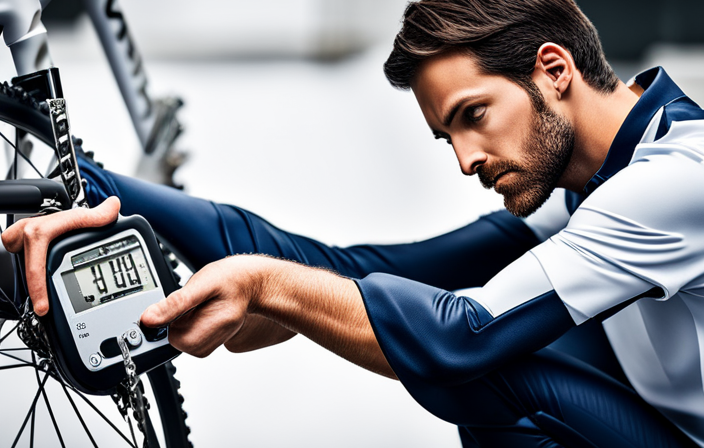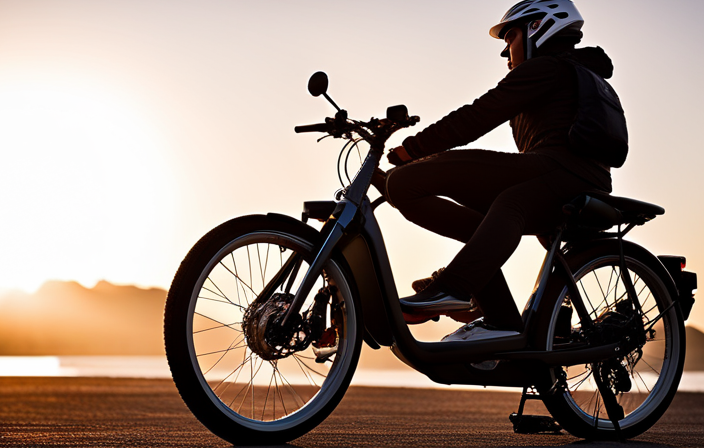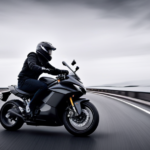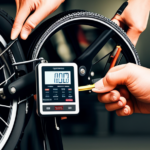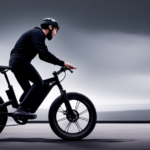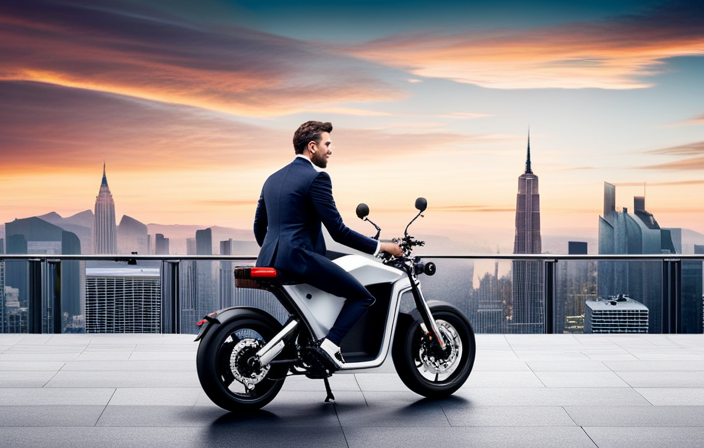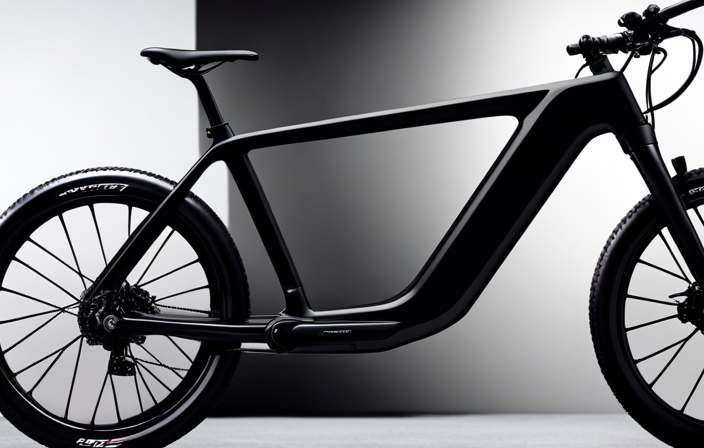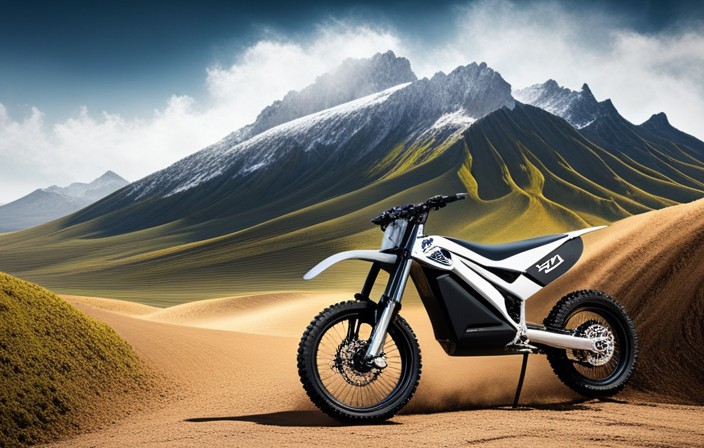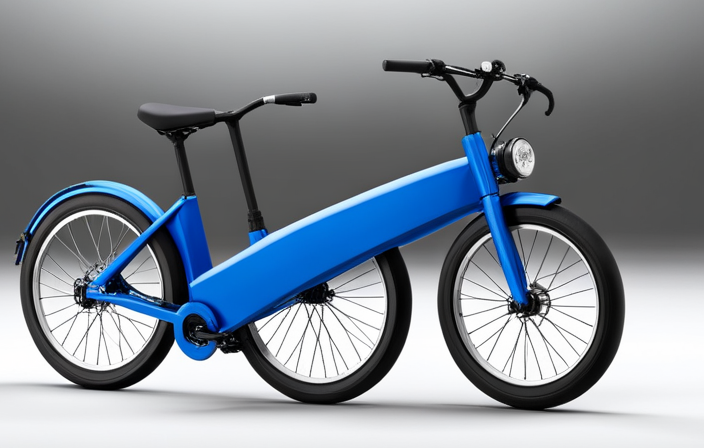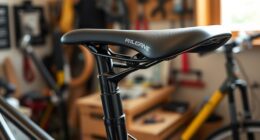Are you interested in maximizing the performance and lifespan of your electric bike hub motor? Learn how to properly test this crucial component with our detailed guide.
With a basic understanding of hub motors, safety precautions, and the necessary equipment, you’ll be equipped to evaluate power output, speed, torque, efficiency, and more.
Don’t let any abnormal noises or vibrations go unnoticed – learn how to troubleshoot common issues and error codes.
Take control of your electric bike’s performance and extend its lifespan with regular maintenance and care.
Key Takeaways
- Troubleshoot common issues and error codes associated with electric bike hub motors.
- Understand the meaning and causes of common error codes such as E01, E02, E03, and E04.
- Follow a regular maintenance schedule to ensure optimal performance of the motor.
- Test and inspect hall sensors, controller and motor connections, and throttle functionality to identify and resolve any malfunctions.
Basic Understanding of Electric Bike Hub Motors
You should start by gaining a basic understanding of electric bike hub motors. Electric bike maintenance is crucial for ensuring optimal performance and longevity.
Hub motors are a popular choice for electric bikes due to their numerous advantages. They are integrated into the wheel hub, allowing for a more streamlined and compact design. This also provides better weight distribution and a lower center of gravity, resulting in improved stability and handling. Hub motors are also quieter and require less maintenance compared to other types of motors.
To properly test an electric bike hub motor, it is important to follow safety precautions and have the necessary equipment. These precautions and equipment will ensure a safe and accurate testing process.
Safety Precautions and Equipment Needed for Testing
Before beginning the process, it is important to take necessary safety precautions and gather the required equipment for assessing the electric bike hub motor. Ensure you have the appropriate safety gear, such as gloves and safety glasses, to protect yourself from any potential hazards. Additionally, make sure you have a multimeter to measure voltage and current, as well as a torque sensor to test the motor’s power output accurately.
You will also need a load resistor to simulate the load on the motor during testing. Lastly, have a suitable workspace with proper ventilation and a fire extinguisher nearby in case of any emergencies. These safety precautions and equipment are crucial to ensure a safe and successful testing process.
Moving forward, let’s dive into the step-by-step guide to testing the motor’s power output.
Step-by-Step Guide to Testing the Motor’s Power Output
To accurately assess the power output of the motor, follow these step-by-step instructions.
-
Connect the motor to a power source and ensure all safety precautions are in place.
-
Attach a power meter to the motor to measure the power output.
-
Begin the testing procedures by gradually increasing the power input and recording the corresponding power output readings.
-
Take multiple measurements at different power levels to obtain a range of data.
-
Once testing is complete, analyze the data to determine the motor’s power output.
-
Look for any patterns or inconsistencies in the readings.
This information will help you assess the motor’s performance and make any necessary adjustments.
Transitioning to checking the motor’s speed and torque performance, it is important to conduct additional tests.
Checking the Motor’s Speed and Torque Performance
Once connected to a power source, you can assess the motor’s speed and torque performance. To measure the motor’s speed, you will need a tachometer. Attach the tachometer to the motor’s shaft and record the revolutions per minute (RPM). This will give you an indication of how fast the motor can rotate. To evaluate the motor’s torque, you can use a torque meter. Connect the torque meter to the motor’s output shaft and apply a load. The torque meter will measure the amount of force the motor can generate. Additionally, it is essential to monitor the motor’s acceleration and heat output during testing. A higher acceleration indicates a more powerful motor, while excessive heat output can indicate an inefficient motor. By understanding the motor’s speed, torque, acceleration, and heat output, you can gather valuable insights into its performance. In the next section, we will discuss assessing the motor’s efficiency and energy consumption.
Assessing the Motor’s Efficiency and Energy Consumption
To accurately assess the motor’s efficiency and energy consumption, you need to monitor its power output and measure the amount of energy it consumes. This will give you valuable insights into the motor’s durability and performance.
When analyzing the motor’s heat dissipation, there are several factors to consider. First, you should observe the temperature of the motor during operation and ensure it stays within a safe range. Second, you can assess the motor’s cooling system and evaluate its effectiveness in dissipating heat.
Finally, you can perform endurance tests to examine how the motor performs under prolonged usage and high-stress conditions. By thoroughly evaluating the motor’s efficiency, energy consumption, and heat dissipation, you can gain a comprehensive understanding of its overall performance and durability.
This knowledge will help you make informed decisions and ensure optimal performance in different terrains and riding conditions.
Testing the Motor’s Response to Different Terrain and Riding Conditions
Now that you have assessed the motor’s efficiency and energy consumption, it’s time to test the motor’s response to different terrain and riding conditions.
This step is crucial in determining the motor’s durability and longevity. By subjecting the motor to various riding conditions such as uphill climbs, off-road trails, and smooth roads, you can gauge its performance and reliability under different stress levels.
Pay close attention to how the motor handles these situations and whether it maintains a consistent level of power output. Additionally, it is important to analyze the motor’s heat dissipation capabilities during these tests, as excessive heat can lead to premature wear and tear.
Once you have thoroughly evaluated the motor’s response to different terrain and riding conditions, you can proceed to the next section where we will check for any abnormal noises or vibrations.
Checking for Any Abnormal Noises or Vibrations
Check if you hear any unusual noises or feel any vibrations while riding the electric bike with the hub motor. Abnormal noises or vibrations could indicate potential issues with the motor or its components. Troubleshooting these issues is crucial for the maintenance and lifespan of the electric bike. To help you identify any problems, refer to the table below for common abnormal noises and vibrations, possible causes, and suggested actions:
| Abnormal Noises/Vibrations | Possible Causes | Suggested Actions |
|---|---|---|
| Grinding noise | Misaligned gears or bearings | Check and realign gears or replace bearings |
| Whirring noise | Loose or damaged motor components | Tighten or replace loose or damaged components |
| Excessive vibrations | Unbalanced wheel or loose spokes | Balance the wheel or tighten loose spokes |
Efficiency and the motor’s response to different terrain and riding conditions can be affected by abnormal noises or vibrations. After checking for any issues, proceed to the next step of inspecting the motor’s wiring and connections to ensure optimal performance and safety.
Inspecting the Motor’s Wiring and Connections
Take a moment to inspect the wiring and connections of your motor to ensure they’re properly connected and functioning. This step is crucial in identifying any potential issues with the motor’s operation.
Start by checking for loose connections, as these can cause poor performance or even complete motor failure. Make sure all wires are securely connected and there are no signs of fraying or damage.
Additionally, inspect the motor’s exterior for any signs of damage or wear and tear. Look for cracks, dents, or any other abnormalities that may affect the motor’s functionality.
By thoroughly examining the wiring and connections, as well as the motor’s exterior, you can prevent potential problems and ensure the motor is in optimal condition.
Now, let’s move on to troubleshooting common issues and error codes.
Troubleshooting Common Issues and Error Codes
If you encounter any common issues or error codes, troubleshooting them can help identify and resolve the problem. When it comes to diagnosing motor problems, it’s important to be familiar with the error codes that may appear on your electric bike hub motor. Here is a table outlining some common error codes and their possible causes:
| Error Code | Possible Cause | Solution |
|---|---|---|
| E01 | Motor overheating | Check for obstructions in the motor, ensure proper ventilation |
| E02 | Hall sensor failure | Inspect the hall sensors, replace if necessary |
| E03 | Controller communication error | Check connections between the controller and motor, ensure they are secure |
| E04 | Throttle malfunction | Test the throttle, replace if needed |
By understanding these error codes and their potential causes, you can troubleshoot and address any issues that may arise with your electric bike hub motor. Regular maintenance and care tips for prolonging the motor’s lifespan will be discussed in the next section.
Regular Maintenance and Care Tips for Prolonging the Motor’s Lifespan
Now that you’ve learned how to troubleshoot common issues and error codes with your electric bike hub motor, it’s time to focus on regular maintenance and care tips to ensure its longevity.
Following a proper maintenance schedule is essential for keeping your motor running smoothly. This includes regular cleaning to prevent dirt and debris from accumulating on the motor and affecting its performance. When cleaning, make sure to use gentle techniques such as wiping with a soft cloth or using a mild detergent solution. Avoid using high-pressure water or abrasive cleaners that could damage the motor.
Additionally, check for any loose connections or worn-out parts that may need to be replaced. By incorporating these maintenance practices into your routine, you can prolong the lifespan of your electric bike hub motor and enjoy many trouble-free rides.
Frequently Asked Questions
How can I determine if my electric bike hub motor is compatible with my bike frame?
To determine if your electric bike hub motor is compatible with your bike frame, you need to consider the motor’s specifications and compare them to your frame’s requirements. Troubleshooting issues may arise if there is a mismatch in size, mounting points, or axle compatibility.
What are the recommended safety precautions when testing an electric bike hub motor?
When testing an electric bike hub motor, it is important to prioritize safety. Wear appropriate safety gear, such as a helmet and protective clothing. Use the necessary testing equipment, such as a multimeter, to ensure accurate results and minimize potential hazards.
Is it possible to test the motor’s power output without specialized equipment?
To test the power output of an electric bike hub motor without specialized equipment, you can use alternative options such as an electric power meter or a dynometer. These testing methods provide accurate measurements and allow you to assess the motor’s performance.
How can I check the motor’s efficiency and energy consumption during testing?
To check the motor’s efficiency and energy consumption, measure the motor’s torque using a torque sensor. Assess the motor’s heat dissipation through infrared thermography or by monitoring the motor’s temperature using a thermal sensor.
Are there any specific riding conditions or terrains that should be included when testing the motor’s response?
When testing the motor’s response, it is important to consider various riding conditions and terrains. These factors can affect the motor’s performance and help evaluate its capabilities in real-world scenarios.
Conclusion
In conclusion, testing an electric bike hub motor is crucial to ensure its optimal performance and longevity. By following the step-by-step guide and conducting regular maintenance, you can keep your motor running smoothly and efficiently.
Remember, just like a well-oiled machine, the motor is the heart of your electric bike. So, treat it with care and attention, and it will propel you forward on your cycling adventures, like a steady breeze guiding you towards your destination. Regular maintenance and proper handling will ensure its longevity, keeping your rides smooth and enjoyable. Understanding how to operate an electric bike correctly, from managing battery life to using pedal assist efficiently, can make a significant difference in performance. With the right care, your bike will remain a reliable companion on every journey.
Happy riding!
